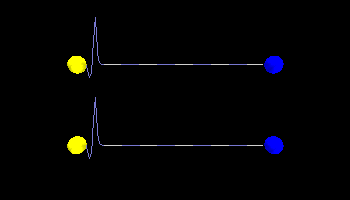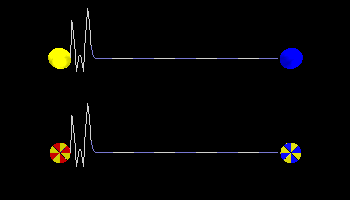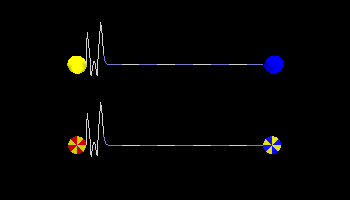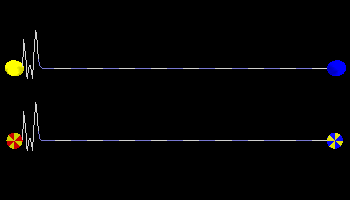"There is nothing more difficult to take in hand, more perilous to conduct, or more uncertain in its success, than to take a lead in the introduction of a new order of things, because the innovator has for enemies all those who have done well under the old conditions, and lukewarm defenders in those who may do well under the new."
- Nicolo Machivelli -
Expanding Universe
To show what happens to photons as they travel great distances across the universe, I have created four simulations. I made an array of one hundred spheres (nodes) and joined them by springs and dampers to simulate foamy ether. (The behavior of this model is very similar to a long bungee cord). I then attached one end to a yellow ball (representing a distant star) and the other end to a blue ball (representing the Earth). If you flick one end of this bungee cord you cause a transverse wave to travel from one end to the other. This is very similar to what happens in foamy ether, as explained in Figure 21.
The top half of Figure 25a shows a star emitting a photon. The wave travels through the ether until it eventually reaches the Earth (notice that its wavelength doesn't change). The bottom half of Figure 25a shows the same star emitting a photon in an expanding universe. To demonstrate this, I caused the the star and the Earth to slowly move apart, causing the bungee cord (foamy ether) to stretch. (The blue and white dashed pattern on the bungee cord shows that the stretching is uniformly distributed along its full length). While the photon is in transit, the ether stretches, thereby causing the photon's wavelength to increase. This increase in wavelength is what cosmologists refer to as the redshift.
Because most distant galaxies exhibit a redshift, it has been concluded that the universe is expanding in all directions. And a galaxy that is further away shows more redshift because the photon has been in transit for a longer period of time while the ether stretched. In this instance, the Doppler effect is not causing the redshift. The galaxies are not moving through ether. They float along with the ether as it stretches. Nor are there any 'time dilation' effects, as stated in special relativity, since (again) the galaxies are not moving through ether.

Figure 25a
Notice, also, in Figure 25a, that the two photons reach the Earth at the same time, even though the bottom photon has a greater distance to travel. This is because the speed of light actually increases as the ether stretches. This also explains why space and time are so inextricably linked into what relativity calls 'space-time'. When you stretch space (foamy ether), you increase its tension so that the speed of light also increases.
Ether theory predicts that not all of this redshift is caused by the expansion of the universe. Part of the ether stretching is caused by ether inflow around large astronomical bodies (as shown in Figure 9). Figure 25b illustrates how this inflow can also cause ether to stretch. I put a spoke-like pattern on the bottom star and on the Earth, and caused them to rotate to indicate that they are constantly pulling, or reeling in the ether (similar to how a tape measure reels in the tape when you let it go). By watching the blue and white dashed pattern, you can see that the ether is indeed stretching. This causes both the photon's wavelength and its propagation speed to increase. The only affect that an observer on Earth notices is the redshift. So one cannot conclude that the redshift is caused by cosmic expansion alone, but may also be caused by ether inflow.

Figure 25b
Figure 25c shows what happens when both expansion and inflow occur. The star and the Earth are both reeling in the ether as they steadily move apart. This causes the ether to be stretched more quickly than from expansion alone, thus producing more redshift. This additional redshift from inflow, I believe, is what causes cosmologists to falsely conclude that the expansion rate of the universe is actually increasing. Since inflow accounts for some of the redshift, the universe is not expanding as rapidly as current theory suggests.

Figure 25c
Of course, expansion with inflow is not the only possible scenario. At some point in time, our universe may stop expanding, leaving inflow as the only cause of ether stretching and redshift. When the universe starts collapsing, the ether inflow may still cause red-shifting to take place, until the rate of collapse catches up to the the rate of inflow (see Figure 25d). Then distant galaxies will exhibit blue shifting as the ether starts shrinking.
So the universe may not actually be expanding, but could be at the beginning of collapse, where ether inflow is the only cause of redshift.

Figure 25d
